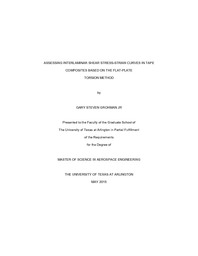
ATTENTION: The works hosted here are being migrated to a new repository that will consolidate resources, improve discoverability, and better show UTA's research impact on the global community. We will update authors as the migration progresses. Please see MavMatrix for more information.
Show simple item record
| dc.contributor.author | Grohman, Gary Steven | en_US |
| dc.date.accessioned | 2015-07-31T22:09:55Z | |
| dc.date.available | 2015-07-31T22:09:55Z | |
| dc.date.submitted | January 2015 | en_US |
| dc.identifier.other | DISS-12763 | en_US |
| dc.identifier.uri | http://hdl.handle.net/10106/24989 | |
| dc.description.abstract | Composites are attractive for structural applications in the aerospace industry for their high strength to weight ratio, stiffness, and low density. The development and implementation of composite structures has grown rapidly through the aerospace industry exceeding our ability to characterize the material properties due to costly and time consuming test methods. The ability to fully characterize the nonlinear stress-strain relationship in the 1-3 and 2-3 principal planes up to the point of failure is extremely important for predicting failures in composites. The principal directions for composites are the fiber direction, transverse direction, and the thru thickness direction, commonly referred to as the 1, 2, 3 directions. Conventional testing such as short beam shear (SBS) and V-notch tests are used in industry to determine the interlaminar shear properties of composites. With the use of the digital image correlation (DIC) technique and finite element analysis (FEA), SBS tests have been developed to include the measurement of multiple material constitutive properties, including nonlinear interlaminar shear stress-strain curves in the 1-3 principal material plane. However, SBS and V-notch testing are limited to measuring linear interlaminar shear material properties in the 2-3 direction, due to premature tensile failure due to bending before the stress-strain relation becomes nonlinear. By loading a flat plate composite specimen in compression with the contact surfaces on the corners of the opposite upper and lower surface to create a torsional deformation, significant nonlinear shear strain is developed on all principal material planes. Using DIC, the nonlinear interlaminar shear strain can be obtained in the 2-3 direction experimentally. Multiple test methods were conducted to assess the effects of different configurations to eliminate the sensitivity of the placement of the loading surfaces and by varying the length, width, and thickness of the specimen and the diameters and shapes of the loading nodes. Measured material properties from SBS tests were used as an initial approximation in an iterative FEA implemented using Abaqus. The FEM based stresses calculated in the flat plate torsion specimens were used to establish the interlaminar shear stress-strain curves based on the surface strain components measured using DIC. Strain data was simultaneously captured on the 1-3 and 2-3 planes. Analysis of the 1-3 plane using the flat plate torsion method was verified with SBS testing. Analysis in the 2- 3 planes was verified in the linear region of SBS and provides an indication that the FPT test method can accurately measure nonlinear interlaminar shear in the 2-3 plane. | en_US |
| dc.description.sponsorship | Makeev, Andrew | en_US |
| dc.language.iso | en | en_US |
| dc.publisher | Aerospace Engineering | en_US |
| dc.title | Assessing Interlaminar Shear Stress-strain Curves In Tape Composites Based On The Flat-plate Torsion Method | en_US |
| dc.type | M.S. | en_US |
| dc.contributor.committeeChair | Makeev, Andrew | en_US |
| dc.degree.department | Aerospace Engineering | en_US |
| dc.degree.discipline | Aerospace Engineering | en_US |
| dc.degree.grantor | University of Texas at Arlington | en_US |
| dc.degree.level | masters | en_US |
| dc.degree.name | M.S. | en_US |
Files in this item
- Name:
- Grohman_uta_2502M_12763.pdf
- Size:
- 1.771Mb
- Format:
- PDF
This item appears in the following Collection(s)
Show simple item record


